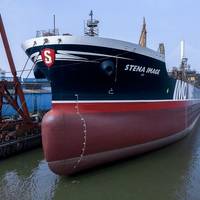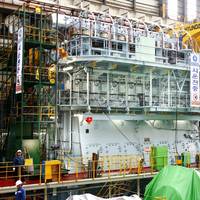MHI Hybrid Turbochargers Awarded for Efficiency
Hybrid Turbocharger developed by Mitsubishi Heavy Industries Marine Machinery & Engine Co., Ltd. (MHI-MME), received the President Award 2015 in the 36th Energy-Efficient Machinery Award from Japan Machinery Federation (JMF). This Hybrid Turbocharger, which incorporates high speed generator motor in Mitsubishi MET Turbocharger, can convert excessive exhaust gas energy of large marine diesel engine into electric power efficiently and flexibly. Furthermore, it can turn into motoring mode so that turbocharger rotor can be accelerated by external electric power. This can supply more air with lower electric power than conventional auxiliary blower makes.
Next Gen Tankers Delivered to Concordia Maritime

Concordia Maritime’s first chemical and product tanker based on the IMOIIMAX concept, the Stena Image, was delivered from the Chinese shipyard GSI (Guangzhou Shipbuilding International) in Guangzhou. The vessel, a 50,000 dwt MR tanker, is equipped with 18 tanks of the same size, each with a capacity of 3,000 m3, able to load vegetable oils and chemicals as well as petroleum products. The technical design has enabled fuel consumption, when sailing at service speed, to be reduced by 10-20% compared with other vessels of the same size.
Maersk Londrina

Maersk Londrina is a 8700 TEU containership built by Daewoo Shipbuilding & Marine Engineering Co., LTD (DSME) for A.P. Moller - Maersk A/S. According the shipbuilder, one of the biggest challenges during construction was to increase the height of the accommodation by 9m in order to achieve the carrying capacity of 8,700 TEU from 7,450 TEU for the previous vessels. In spite of the difficulties of this kind of big modification during construction, the conversion was successfully completed and satisfactory to the shipowner.
Wärtsilä to Supply Main Engines for Kuwait Oil Tanker
Wärtsilä's RT-flex common rail engine technology provides environmental benefits including low fuel consumption and reductions in exhaust emissions. The engine waste heat is utilized to produce onboard electricity. These features help maintaining and operating seaborne transportation in more economical and sustainable ways. Wärtsilä will supply the main engines for a series of vessels being built for Kuwait Oil Tanker Co. (KOTC), a Subsidiary of Kuwait Petroleum Corporation. Four VLCCs (Very Large Crude Oil Carriers), one Aframax tanker and four medium-range tankers are being built at the Daewoo Shipbuilding & Marine Engineering (DSME) shipyard in South Korea.
Wärtsilä Main Engines Ordered for Nine Kuwait Oil Tankships

Wärtsilä to supply main engines for a series of 9 large vessels being built by Daewoo for Kuwait Oil Tanker Co. Four VLCCs (Very Large Crude Oil Carriers), one Aframax tanker and four medium-range tankers are being built at the Daewoo Shipbuilding & Marine Engineering (DSME) shipyard in South Korea. The VLCCs will be fitted with 7-cylinder Wärtsilä RT-flex 82T engines and a Waste Heat Recovery System, which utilizes exhaust gas energy to generate steam which is used to operate a turbo generator that produces ship's electricity supply.
MAN Diesel & Turbo Improves WHR Systems
MAN Diesel & Turbo used the world premiere of its MAN B&W ME-GI gas engine in Copenhagen to present efficiency technologies for its twostroke engines, namely its WHR (Waste Heat Recovery) systems, that include its TCS-PTG turbines, and which are offered as an integrated solution. WHR exploits exhaust-gas energy and is designed to be used in the production of electricity to cover a ship’s electrical needs. All ME- and MC- types in MAN Diesel & Turbo’s engine portfolio are suitable for WHR where, generally speaking, the greater the engine output, the greater the potential WHR offers. As a result, WHR technology has traditionally been applied to container-ship and power-station applications.









